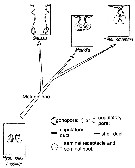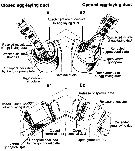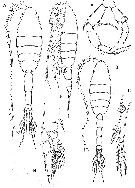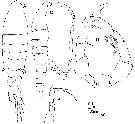|
|
 |
| Metridinidae Sars, 1902 ( Arietelloidea ) | | Syn.: | Metridiidae Sars, 1902 (1903) (p.110); Sewell, 1932 (p.247); Gurney, 1931 a (p.84); Rose,1933 a (p.175); Sewell, 1947 (p.165), Rem.; Brodsky, 1950 (1967) (p.81, 289); Mazza, 1967 (p.185); Andronov, 1974 a (p.1005); Brodsky & al., 1983 (p.141, 145); Zheng Zhong & al., 1984 (1989) (p.242) | | Ref.: | Dunn & Hulsemann, 1979 (p.53: emend.); Razouls, 1982 (p.405); 1993 (p.307); Bowman & Abele, 1982 (p.9); Bull. Zool. Nomencl, 1984 ( N°41,1, p.19); Sazhina, 1985 (p.114, Nauplius); Mauchline, 1988 (p.711: cuticular pores); Huys & Boxshall, 1991 (p.464); Madhupratap & al., 1996 (p.863, Table 5: %/copepods); Chihara & Murano, 1997 (p.837); Cuoc & al., 1997 (p.651, Fig.6: female genital area); Bradford-Grieve & al., 1999 (p.883, 901, 903, 947, Genera Key); Bradford-Grieve, 1999 b (p.110, Déf., Rem.); Soh & al., 1999 (p.122, phylogeny); Ohtsuka & Huys, 2001 (p.461); Boxshall & Halsey, 2004 (p.13; 49; 145: Def.; p.146: Genera Key); Vives & Shmeleva, 2007 (p.356, clé des Genera Key); Blanco-Bercial & al., 2011 (p.103, Table 1, Fig.2, 3, 4, Biol. mol, phylogeny); Laakmann & al., 2019 (p.330, fig. 2, 3, phylogenetic relationships); Hirai & al., 2020 (p.1, Fig.4: metabarcoding, Fig.8: OTUs distribution patterns, Fig.9: phylogenetic analysis )
Bradford-Grieve J.M., (2002 onwards). Key to calanoid copepod families. Version 1 : 2 oct 2002. http://www.crustacea.net/crustace/calanoida/index.htm  | | Rem.: | After Madhupratap & al. (1996), la famille des Metridinidae représente de 0,3 à 5,7 % des copepodes selon la saison dans la couche de mélange des eaux océaniques de la région ouest de l'Inde (Mer Arabe), en usant un filet type Multiple Plankton Closing Net à 200 µm de vide de maille (mesh aperture).
3 G.: Gaussia, Metridia, Pleuromamma. |  issued from :C. Cuoc, D. Defaye, M. Brunet, R. Notonier & J. Mazza in Mar. Biol., 1997, 129. [p.13, Fig.6]. Diagrammatic representation of main evolutionary trends in organization of female genital area in calanoïds for Metridinidae (modified after Huys & Boxshall, 1991 and Ohtsuka & al., 1994). *: seminal duct of Pleuromamma may be situated on left or right, according to individual. |
 issued from :C. Cuoc, D. Defaye, M. Brunet, R. Notonier & J. Mazza in Mar. Biol., 1997, 129. [p.661, Fig.5]. Metridinidae. Schematic three-dimensional interpretation of structure and function of egg-laying ducts. A1, A2 Dorsal representations of egg-laying duct when closed (A1) and open (A2). B1, B2 details of part duct when closed (B1) and open (B2), showing how contraction and relaxation of muscles of egg-laying duct resulut in coordinated opening and closing of the gonopores and seminal ducts (black arrows), allowing release of gametes (open arrows) (the shell ducts, which open into the egg-laying ducts, are not shown on diagram). |
 Issued from : G.A. Boxshall & S.H. Halsey in An Introduction to Copepod Diversity. The Ray Society, 2004, No 166, Part. I. [p.145]. Armature formula of swimming legs P1 to P4. Nota: Female P5 with transverse plate formed by fusion of coxae and intercoxal sclerite; each leg uniramous, comprising basis plus 1, 2 or 3-segmenhted exopod; basis and 1st exopodal segment typically with outer seta and spine respectively, 2nd exopodal segment with outer spine and inner seta, 3rd segment with 2 to 4 distal elements (I-0; II,I,3 in Metridia); 2nd and 3rd exopodal segments often fused, which setation reduced. - Male P5 asymmetrical, carried on plate formed by fused coxae and intercoxal sclerite. Right leg comprising basis with outer seta and 3-segmented exopod; 2nd exopodal segment with inner spinous process in some genera; 3rd segment with 1 or 2 minute distal setae. left leg comprising basis with outer seta and 2 or 3-segmented exopod; 1st exopodal segment bearing curved inner process, distal segment swollen, often curved or claw-like. - Eggs released into water. |
 Issued from : G.A. Boxshall & S.H. Halsey in An Introduction to Copepod Diversity. The Ray Society, 2004, No 166, Part. I. [p.147, Fig.31]. Metridinidae: A, Metridia princeps habitus female; B, P2; C, female P5; D, habitus male; E, male P5; F, Pleuromamma xiphias habitus female. [Dars, 1924]. |
 Issued from : J.M. Bradford-Grieve in NIWA Biodiversity memoir 111, 1999. [p.110]. Spine and seta formula typically (but sometimes reduced) of the swimming legs P1 to P4. - Female P5 uniramous , small, symmetrical 2-4-segmented, basipod 1 and coupler (= intercoxal sclerite) fused; basipod 2 and exopod segment 1 usually with an outer setae and spine respectively; exopod segment 2 with 2-4 setae, terminal exopod segments may be fused. - Male P5 assymmetrical, attached to a plate formed from fusion of basipod 1 and coupler; right leg (or left) comprising basipod 2 with an outer seta and a 2?-3-segmented exopod; exopod segment 2 with an inner spinous process in some genera; exopod segment 3 with 1 or 2 minute distal setae; left leg (or right) comprising basipod 2 with an outer seta and a 2-or 3-segment exopod; exopod segment 1 bearing a curved inner process, distal segment swollen, often curved or claw-like. | | | | | (1) Gaussia Wolfenden, 1905 | |
| | Ref.: | Wolfenden, 1905 a (p.5); 1911 (p.289); Sewell, 1932 (p.176); Davis, 1949 (p.50); Brodsky, 1950 (1967) (p.312); Tanaka, 1963 (p.26); Barnes & Case, 1972 (p.66: Rem.); Saraswathy, 1973 (p.190, Redef.); Razouls, 1982 (p.418); Gardner & Szabo, 1982 (p.347); Mauchline, 1988 (p.709); Björnberg & Campaner, 1988 (p.351); Hulsemann, 1988 (p.188); Razouls, 1993 (p.307); Mauchline, 1998 (p.67); Bradford-Grieve & al., 1999 (p.948: clé spp.); Bradford-Grieve, 1999 b (p.110, Déf., Rem.); Soh & al., 1999 (p.122, phylogeny); Boxshall & Halsey, 2004 (p.146); Vives & Shmeleva, 2007 (p.357) | | Rem.: | Type: Pleuromma princeps T. Scott, 1894. Total: 4 spp. | | Remarques sur les dimensions et le sex-ratio: | | La moyenne des longueurs des femelles est de 10,09 mm (n= 4; S= 0,477; Cv= 0,047) et de 9,60 mm pour les mâles (n= 3; S= 0,854; Cv= 0,089). Le rapport des longueurs (M/F) est de 0,948 ou 94,8 % (n= 3; S= 0,046; Cv= 0,049) |  Issued from : J.M. Bradford-Grieve in NIWA Biodiversity Memoir 111, 1999. [p.111, Fig.74]. Gaussia princeps. Female: A, dorsal view; B, P5. Male: C, lateral view; D, P5 (R = right leg, L = left leg). | | | | | | Ref.: | Giesbrecht, 1892 (p.61, 339); Giesbrecht & Schmeil, 1898 (p.105, spp. Key); Sars, 1900 (p.99); Wheeler, 1901 (p.175); Sars, 1902 (1903) (p.110); Esterly, 1905 (p.177); van Breemen, 1908 a (p.107, spp. Key); A. Scott, 1909 (p.120); Esterly, 1924 (p.96); Wilson, 1932 a (p.117, spp. Key); Sewell, 1932 (p.247); Rose, 1933 a (p.175, spp. Key); Mori, 1937 (1964) (p.67); Sewell, 1947 (p.165, 166); Farran, 1948 c (n°14, p.3); Davis, 1949 (p.47); Brodsky, 1950 (1967) (p.289, spp. Key); Tanaka, 1963 (p.15); Björnberg, 1972 (p.30, 31); Björnberg & al., 1981 (p.640); Razouls, 1982 (p.405); Gardner & Szabo, 1982 (p.321); Mauchline, 1988 (p.708); Razouls, 1993 (p.307); Bucklin & al., 1995 (p.655); Chihara & Murano, 1997 (p.837); Mauchline, 1998 (p.67); Bradford-Grieve & al., 1999 (p.948, spp. Key); Bradford-Grieve, 1999 b (p.112, Def.); Soh & al., 1999 (p.122, phylogeny); Boxshall & Halsey, 2004 (p.146); Vives & Shmeleva, 2007 (p.359, spp. Key) | | Rem.: | Type: Metridia armata Boeck, 1865 (= Metridia longa (Lubbock, 1854). Total: 25 spp. (dont 3 douteuses) + 3 indet. | | Remarques sur les dimensions et le sex-ratio: | | La moyenne des longueurs des femelles est de 4,858 mm (n= 23; S= 2,580; Cv= 0,53) et de 4,050 mm pour les mâles (n= 22; S= 2,61; Cv= 0,64). Les coefficients de variation traduisent une forte hétérogénéité des tailles (7 espèces ont des longueurs supérieures à 7 mm et 6 inférieures ou égales à 3 mm). Le rapport des longueurs (M/F) est de 0,848 ou 84,8 % (n= 20; S= 0,101; Cv= 0,119). Le sex-ratio (F/M) est de 1,05. | | | | (3) Pleuromamma Giesbrecht, 1898 | |
| | Syn.: | Diaptomus (part.) Lubbock,1856; Pleuromma Claus,1863 (p.195); Giesbrecht, 1892 (p.61, 347); Dahl, 1893 (p.105, clé spp.); Wheeler, 1901 (p.76) | | Ref.: | in Giesbrecht & Schmeil, 1898 (p.108, spp. Key); Sars,1902 (1903) (p.114); Esterly, 1905 (p.174); van Breemen, 1908 a (p.103, clé spp.); A. Scott, 1909 (p.122); Sewell, 1932 (p.263); Wilson, 1932 a (p.123, spp. Key); Steuer, 1932 a (p.42, 62, 83, spp. Key); Rose, 1933 a (p.179, spp. Key); Mori, 1937 (1964) (p.68, spp. Key); Dakin & Colefax, 1940 (p.84, spp. Key); Farran, 1948 f (n°17, p.3); Davis, 1949 (p.51); Brodsky, 1950 (1967) (p.305, key spp.); Tanaka, 1963 (p.22); Owre & Foyo, 1967 (p.70, clé spp.); Björnberg, 1972 (p.30,31); Björnberg & al., 1981 (p.640); Razouls, 1982 (p.412); Gardner & Szabo, 1982 (p.333); Ferrari, 1984 a (p.166: asymmetry); Mauchline, 1988 (p.709); Huys & Boxshall,1991 (p.63, 68); Razouls, 1993 (p.307); Park (J.S) & Mauchline, 1994 (p.107, Rem.: cuticular pores); Beckmann, 1995 (in Monoculus, n°29, p.6: asymmetry); Chihara & Murano, 1997 (p.838); Mauchline, 1998 (p.67); Bradford-Grieve & al., 1999 (p.947, 948: spp. Key); Bradford-Grieve, 1999 b (p.118, Def.); Soh & al., 1999 (p.122, phylogeny); Boxshall & Halsey, 2004 (p.146); Mulyadi, 2004 (p.10, spp. Key for Indonesian Seas); Vives & Shmeleva, 2007 (p.372, spp. Key) | | Rem.: | Type: Diaptomus abdominalis Lubbock,1856. Total: 11 spp. + 1 (juv.?). | | Remarques sur les dimensions et le sex-ratio: | | The mean female size is 3.219 mm (n = 22; SD = 1.2217), and the mean male size is 2.973 mm (n = 22; SD = 1.2018). The size ratio (Male: Female) is 0.918 (n = 11; SD = 0.0893). The sex-ratio (Female: Male) is 1. | | | | |
|
|
 Toute utilisation de ce site pour une publication sera mentionnée avec la référence suivante : Toute utilisation de ce site pour une publication sera mentionnée avec la référence suivante :
Razouls C., Desreumaux N., Kouwenberg J. et de Bovée F., 2005-2025. - Biodiversité des Copépodes planctoniques marins (morphologie, répartition géographique et données biologiques). Sorbonne Université, CNRS. Disponible sur http://copepodes.obs-banyuls.fr [Accédé le 20 novembre 2025] © copyright 2005-2025 Sorbonne Université, CNRS
|
|
 |
 |







